ABS VOLVO XC70 2003 Owners Manual
[x] Cancel search | Manufacturer: VOLVO, Model Year: 2003, Model line: XC70, Model: VOLVO XC70 2003Pages: 257, PDF Size: 5.33 MB
Page 3 of 257
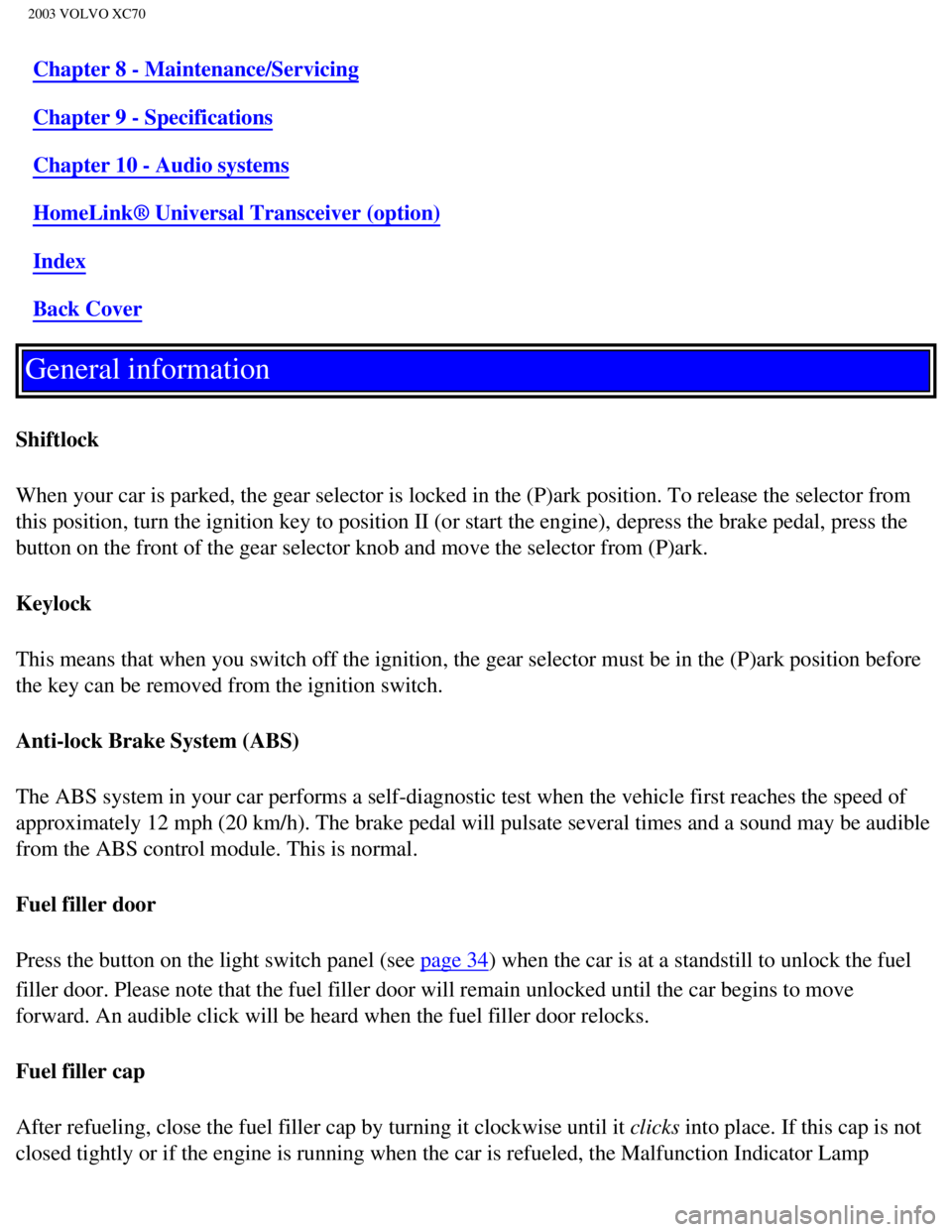
2003 VOLVO XC70
Chapter 8 - Maintenance/Servicing
Chapter 9 - Specifications
Chapter 10 - Audio systems
HomeLink® Universal Transceiver (option)
Index
Back Cover
General information
Shiftlock
When your car is parked, the gear selector is locked in the (P)ark pos\
ition. To release the selector from
this position, turn the ignition key to position II (or start the engin\
e), depress the brake pedal, press the
button on the front of the gear selector knob and move the selector from\
(P)ark.
Keylock
This means that when you switch off the ignition, the gear selector must\
be in the (P)ark position before
the key can be removed from the ignition switch.
Anti-lock Brake System (ABS)
The ABS system in your car performs a self-diagnostic test when the vehi\
cle first reaches the speed of
approximately 12 mph (20 km/h). The brake pedal will pulsate several t\
imes and a sound may be audible
from the ABS control module. This is normal.
Fuel filler door
Press the button on the light switch panel (see
page 34) when the car is at a standstill to unlock the fuel
filler door. Please note that the fuel filler door will remain unlocked \
until the car begins to move
forward. An audible click will be heard when the fuel filler door relock\
s.
Fuel filler cap
After refueling, close the fuel filler cap by turning it clockwise until\
it clicks into place. If this cap is not
closed tightly or if the engine is running when the car is refueled, the\
Malfunction Indicator Lamp
file:///K|/ownersdocs/2003/2003_XC70/03xc70_00.htm (3 of 6)12/30/2006 \
4:17:50 PM
Page 7 of 257
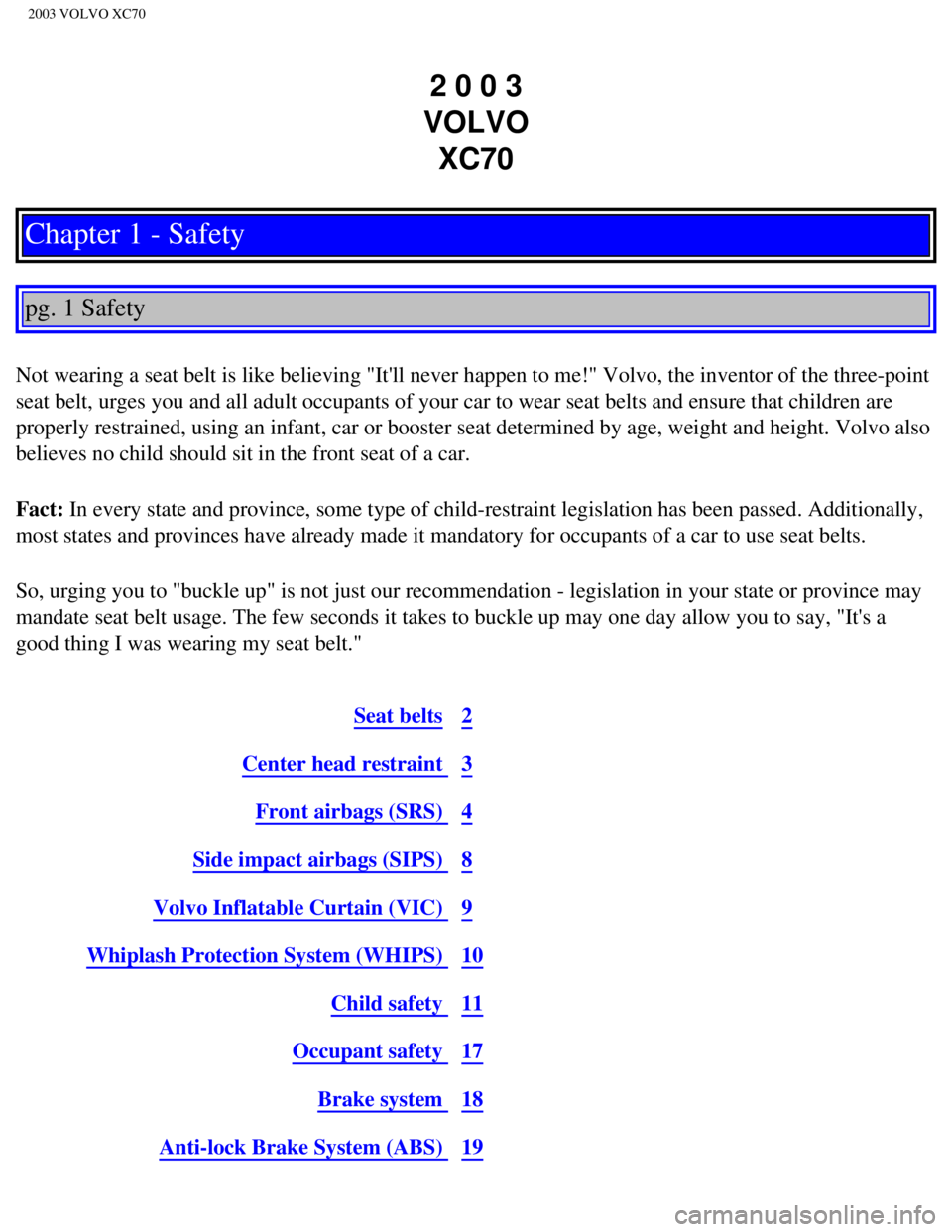
2003 VOLVO XC70
2 0 0 3
VOLVO XC70
Chapter 1 - Safety
pg. 1 Safety
Not wearing a seat belt is like believing "It'll never happen to me!" Vo\
lvo, the inventor of the three-point
seat belt, urges you and all adult occupants of your car to wear seat be\
lts and ensure that children are
properly restrained, using an infant, car or booster seat determined by \
age, weight and height. Volvo also
believes no child should sit in the front seat of a car.
Fact: In every state and province, some type of child-restraint legislation h\
as been passed. Additionally,
most states and provinces have already made it mandatory for occupants o\
f a car to use seat belts.
So, urging you to "buckle up" is not just our recommendation - legislati\
on in your state or province may
mandate seat belt usage. The few seconds it takes to buckle up may one d\
ay allow you to say, "It's a
good thing I was wearing my seat belt."
Seat belts2
Center head restraint 3
Front airbags (SRS) 4
Side impact airbags (SIPS) 8
Volvo Inflatable Curtain (VIC) 9
Whiplash Protection System (WHIPS) 10
Child safety 11
Occupant safety 17
Brake system 18
Anti-lock Brake System (ABS) 19
file:///K|/ownersdocs/2003/2003_XC70/03xc70_01a.htm (1 of 17)12/30/200\
6 4:17:51 PM
Page 22 of 257
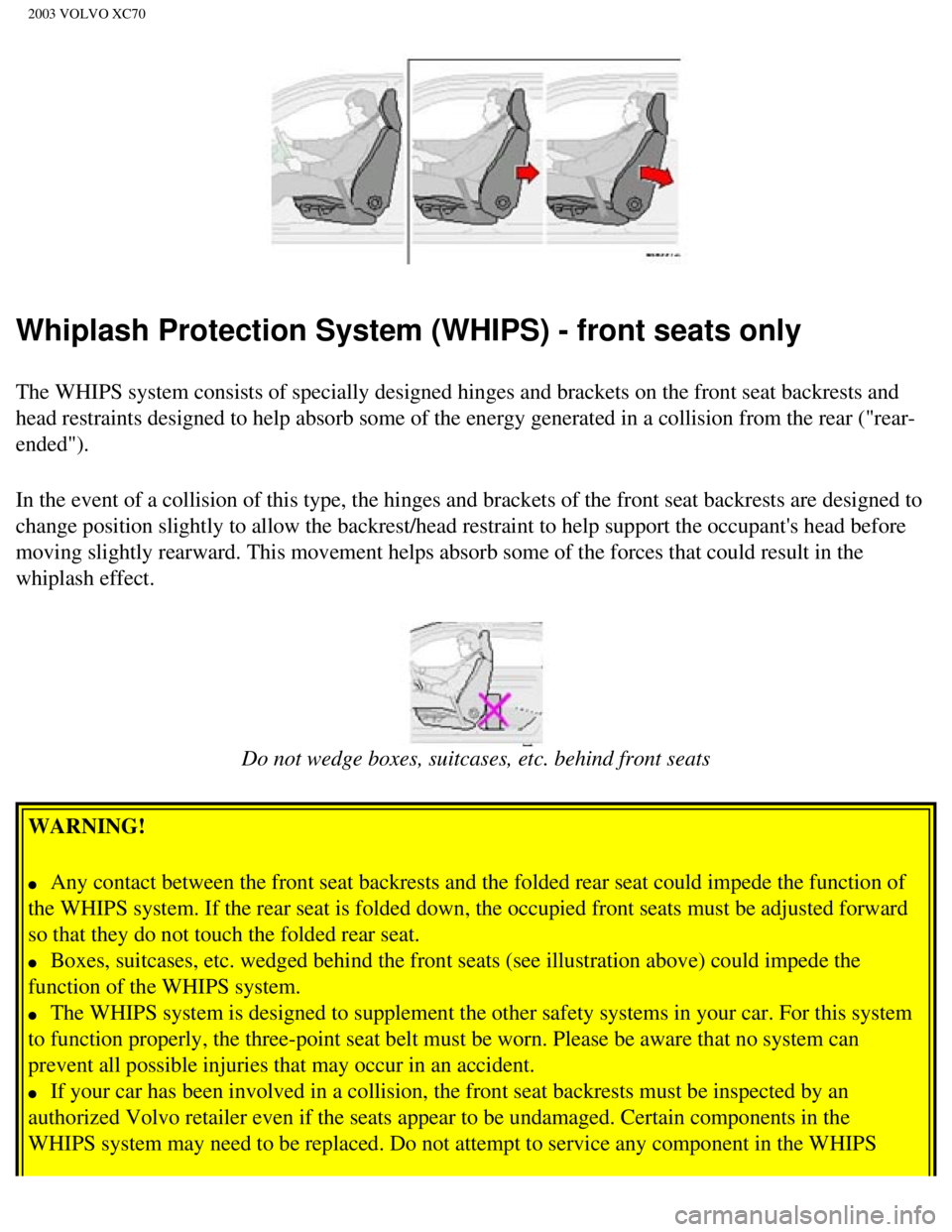
2003 VOLVO XC70
Whiplash Protection System (WHIPS) - front seats only
The WHIPS system consists of specially designed hinges and brackets on t\
he front seat backrests and
head restraints designed to help absorb some of the energy generated in \
a collision from the rear ("rear-
ended").
In the event of a collision of this type, the hinges and brackets of the\
front seat backrests are designed to
change position slightly to allow the backrest/head restraint to help su\
pport the occupant's head before
moving slightly rearward. This movement helps absorb some of the forces \
that could result in the
whiplash effect.
Do not wedge boxes, suitcases, etc. behind front seats
WARNING!
l Any contact between the front seat backrests and the folded rear seat co\
uld impede the function of
the WHIPS system. If the rear seat is folded down, the occupied front se\
ats must be adjusted forward
so that they do not touch the folded rear seat.
l Boxes, suitcases, etc. wedged behind the front seats (see illustration \
above) could impede the
function of the WHIPS system.
l The WHIPS system is designed to supplement the other safety systems in y\
our car. For this system
to function properly, the three-point seat belt must be worn. Please be \
aware that no system can
prevent all possible injuries that may occur in an accident.
l If your car has been involved in a collision, the front seat backrests m\
ust be inspected by an
authorized Volvo retailer even if the seats appear to be undamaged. Cert\
ain components in the
WHIPS system may need to be replaced. Do not attempt to service any comp\
onent in the WHIPS
file:///K|/ownersdocs/2003/2003_XC70/03xc70_01a.htm (16 of 17)12/30/20\
06 4:17:51 PM
Page 31 of 257
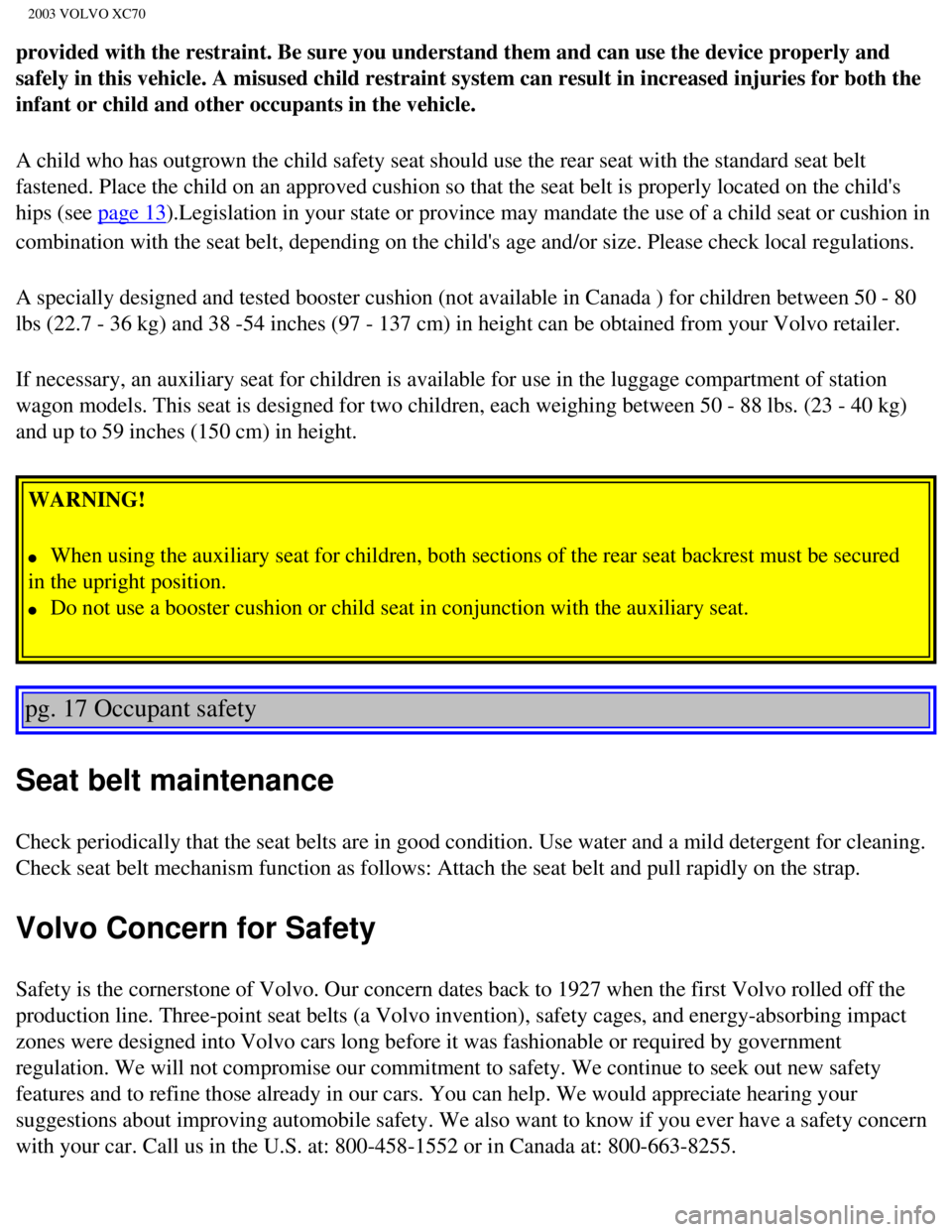
2003 VOLVO XC70
provided with the restraint. Be sure you understand them and can use the\
device properly and
safely in this vehicle. A misused child restraint system can result in i\
ncreased injuries for both the
infant or child and other occupants in the vehicle.
A child who has outgrown the child safety seat should use the rear seat \
with the standard seat belt
fastened. Place the child on an approved cushion so that the seat belt i\
s properly located on the child's
hips (see
page 13).Legislation in your state or province may mandate the use of a child \
seat or cushion in
combination with the seat belt, depending on the child's age and/or size\
. Please check local regulations.
A specially designed and tested booster cushion (not available in Canad\
a ) for children between 50 - 80
lbs (22.7 - 36 kg) and 38 -54 inches (97 - 137 cm) in height can be \
obtained from your Volvo retailer.
If necessary, an auxiliary seat for children is available for use in the\
luggage compartment of station
wagon models. This seat is designed for two children, each weighing betw\
een 50 - 88 lbs. (23 - 40 kg)
and up to 59 inches (150 cm) in height.
WARNING!
l When using the auxiliary seat for children, both sections of the rear se\
at backrest must be secured
in the upright position.
l Do not use a booster cushion or child seat in conjunction with the auxil\
iary seat.
pg. 17 Occupant safety
Seat belt maintenance
Check periodically that the seat belts are in good condition. Use water \
and a mild detergent for cleaning.
Check seat belt mechanism function as follows: Attach the seat belt and \
pull rapidly on the strap.
Volvo Concern for Safety
Safety is the cornerstone of Volvo. Our concern dates back to 1927 when \
the first Volvo rolled off the
production line. Three-point seat belts (a Volvo invention), safety ca\
ges, and energy-absorbing impact
zones were designed into Volvo cars long before it was fashionable or re\
quired by government
regulation. We will not compromise our commitment to safety. We continue\
to seek out new safety
features and to refine those already in our cars. You can help. We would\
appreciate hearing your
suggestions about improving automobile safety. We also want to know if y\
ou ever have a safety concern
with your car. Call us in the U.S. at: 800-458-1552 or in Canada at: 800\
-663-8255.
file:///K|/ownersdocs/2003/2003_XC70/03xc70_01b.htm (8 of 14)12/30/200\
6 4:17:52 PM
Page 34 of 257
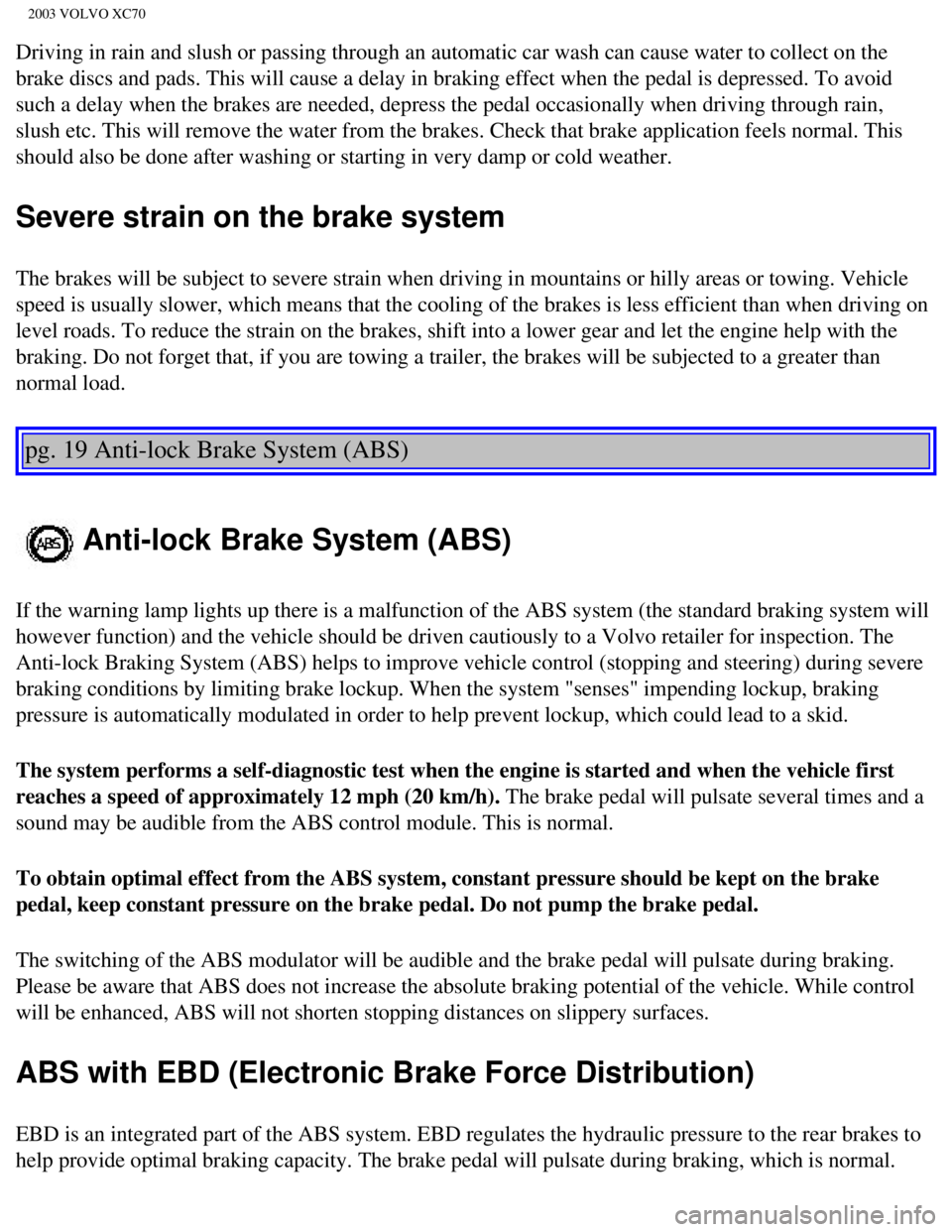
2003 VOLVO XC70
Driving in rain and slush or passing through an automatic car wash can c\
ause water to collect on the
brake discs and pads. This will cause a delay in braking effect when the\
pedal is depressed. To avoid
such a delay when the brakes are needed, depress the pedal occasionally \
when driving through rain,
slush etc. This will remove the water from the brakes. Check that brake \
application feels normal. This
should also be done after washing or starting in very damp or cold weath\
er.
Severe strain on the brake system
The brakes will be subject to severe strain when driving in mountains or\
hilly areas or towing. Vehicle
speed is usually slower, which means that the cooling of the brakes is l\
ess efficient than when driving on
level roads. To reduce the strain on the brakes, shift into a lower gear\
and let the engine help with the
braking. Do not forget that, if you are towing a trailer, the brakes wil\
l be subjected to a greater than
normal load.
pg. 19 Anti-lock Brake System (ABS)
Anti-lock Brake System (ABS)
If the warning lamp lights up there is a malfunction of the ABS system (\
the standard braking system will
however function) and the vehicle should be driven cautiously to a Volv\
o retailer for inspection. The
Anti-lock Braking System (ABS) helps to improve vehicle control (stop\
ping and steering) during severe
braking conditions by limiting brake lockup. When the system "senses" im\
pending lockup, braking
pressure is automatically modulated in order to help prevent lockup, whi\
ch could lead to a skid.
The system performs a self-diagnostic test when the engine is started an\
d when the vehicle first
reaches a speed of approximately 12 mph (20 km/h). The brake pedal will pulsate several times and a
sound may be audible from the ABS control module. This is normal.
To obtain optimal effect from the ABS system, constant pressure should b\
e kept on the brake
pedal, keep constant pressure on the brake pedal. Do not pump the brake \
pedal.
The switching of the ABS modulator will be audible and the brake pedal w\
ill pulsate during braking.
Please be aware that ABS does not increase the absolute braking potentia\
l of the vehicle. While control
will be enhanced, ABS will not shorten stopping distances on slippery su\
rfaces.
ABS with EBD (Electronic Brake Force Distribution)
EBD is an integrated part of the ABS system. EBD regulates the hydraulic\
pressure to the rear brakes to
help provide optimal braking capacity. The brake pedal will pulsate duri\
ng braking, which is normal.
file:///K|/ownersdocs/2003/2003_XC70/03xc70_01b.htm (11 of 14)12/30/20\
06 4:17:52 PM
Page 35 of 257
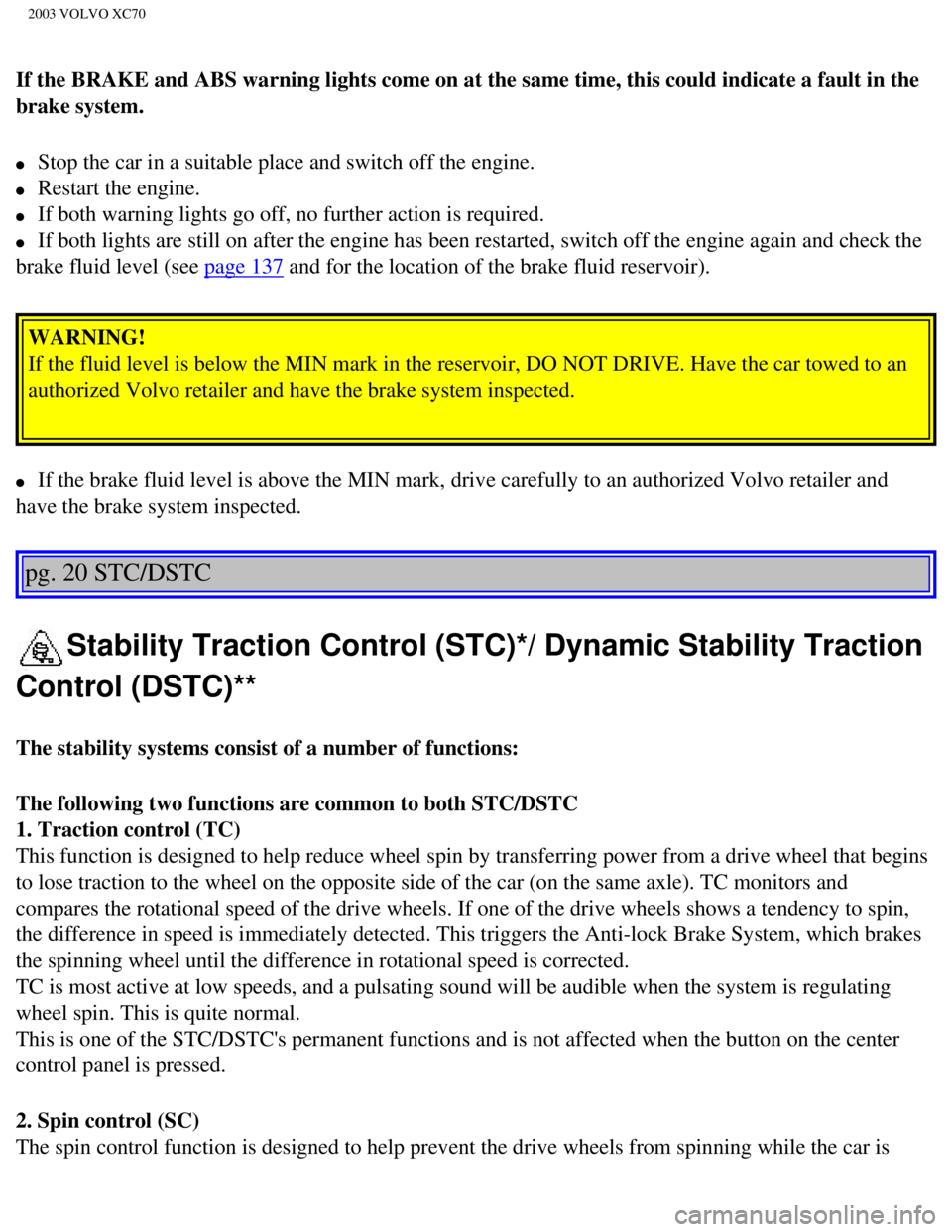
2003 VOLVO XC70
If the BRAKE and ABS warning lights come on at the same time, this could\
indicate a fault in the
brake system.
l Stop the car in a suitable place and switch off the engine.
l Restart the engine.
l If both warning lights go off, no further action is required.
l If both lights are still on after the engine has been restarted, switch \
off the engine again and check the
brake fluid level (see
page 137 and for the location of the brake fluid reservoir).
WARNING!
If the fluid level is below the MIN mark in the reservoir, DO NOT DRIVE.\
Have the car towed to an
authorized Volvo retailer and have the brake system inspected.
l If the brake fluid level is above the MIN mark, drive carefully to an au\
thorized Volvo retailer and
have the brake system inspected.
pg. 20 STC/DSTC
Stability Traction Control (STC)*/ Dynamic Stability Traction
Control (DSTC)**
The stability systems consist of a number of functions:
The following two functions are common to both STC/DSTC
1. Traction control (TC)
This function is designed to help reduce wheel spin by transferring powe\
r from a drive wheel that begins
to lose traction to the wheel on the opposite side of the car (on the s\
ame axle). TC monitors and
compares the rotational speed of the drive wheels. If one of the drive w\
heels shows a tendency to spin,
the difference in speed is immediately detected. This triggers the Anti-\
lock Brake System, which brakes
the spinning wheel until the difference in rotational speed is corrected\
.
TC is most active at low speeds, and a pulsating sound will be audible w\
hen the system is regulating
wheel spin. This is quite normal.
This is one of the STC/DSTC's permanent functions and is not affected wh\
en the button on the center
control panel is pressed.
2. Spin control (SC)
The spin control function is designed to help prevent the drive wheels f\
rom spinning while the car is
file:///K|/ownersdocs/2003/2003_XC70/03xc70_01b.htm (12 of 14)12/30/20\
06 4:17:52 PM
Page 45 of 257
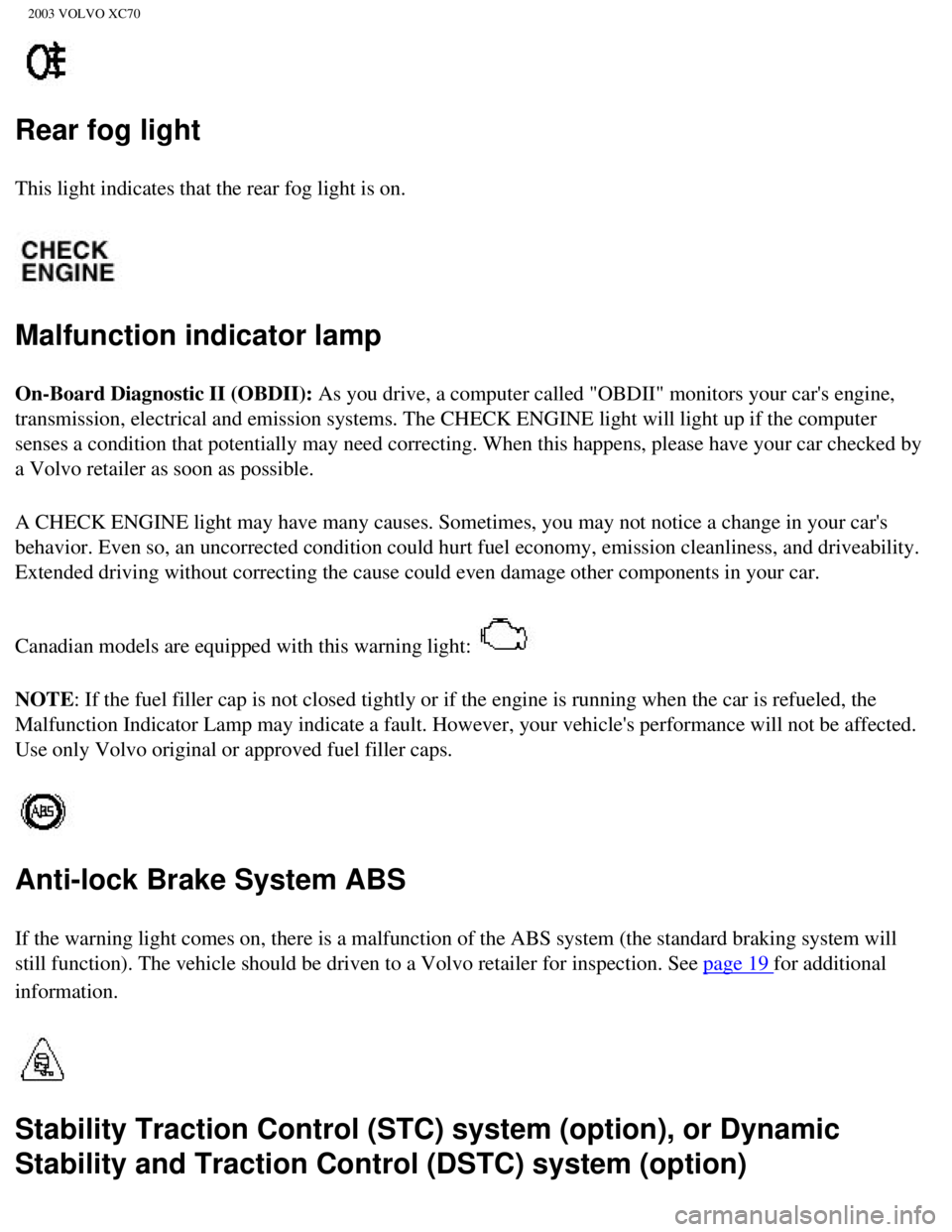
2003 VOLVO XC70
Rear fog light
This light indicates that the rear fog light is on.
Malfunction indicator lamp
On-Board Diagnostic II (OBDII): As you drive, a computer called "OBDII" monitors your car's engine,
transmission, electrical and emission systems. The CHECK ENGINE light wi\
ll light up if the computer
senses a condition that potentially may need correcting. When this happe\
ns, please have your car checked by
a Volvo retailer as soon as possible.
A CHECK ENGINE light may have many causes. Sometimes, you may not notice\
a change in your car's
behavior. Even so, an uncorrected condition could hurt fuel economy, emi\
ssion cleanliness, and driveability.
Extended driving without correcting the cause could even damage other co\
mponents in your car.
Canadian models are equipped with this warning light:
NOTE: If the fuel filler cap is not closed tightly or if the engine is runni\
ng when the car is refueled, the
Malfunction Indicator Lamp may indicate a fault. However, your vehicle's\
performance will not be affected.
Use only Volvo original or approved fuel filler caps.
Anti-lock Brake System ABS
If the warning light comes on, there is a malfunction of the ABS system \
(the standard braking system will
still function). The vehicle should be driven to a Volvo retailer for i\
nspection. See
page 19 for additional
information.
Stability Traction Control (STC) system (option), or Dynamic
Stability and Traction Control (DSTC) system (option)
file:///K|/ownersdocs/2003/2003_XC70/03xc70_02a.htm (8 of 13)12/30/200\
6 4:17:53 PM
Page 98 of 257

2003 VOLVO XC70
NOTE: Make sure that the holes in the plastic ferrules on the top of the backr\
est engage the hooks on
the bottom of the seat cushion. When you later raise the backrest and se\
at cushion, the head restraints
must be returned to their normal positions.
Removing the seat cushion
Models with 2 or 3-section rear seat
Pull up the seat by the handle. Unlock the two red locking tabs. Lift ou\
t the seat. When replacing, do
everything in reverse order. Make sure the red locking tabs are in a loc\
ked position. WARNING!
The red lock indicator is VISIBLE (B) when the backrest is NOT locked \
in position and not visible
(A) when the backrest is correctly locked in place. When the backrest \
is in the upright position, it
must always be correctly locked in place.
file:///K|/ownersdocs/2003/2003_XC70/03xc70_04b.htm (7 of 21)12/30/200\
6 4:17:57 PM
Page 148 of 257
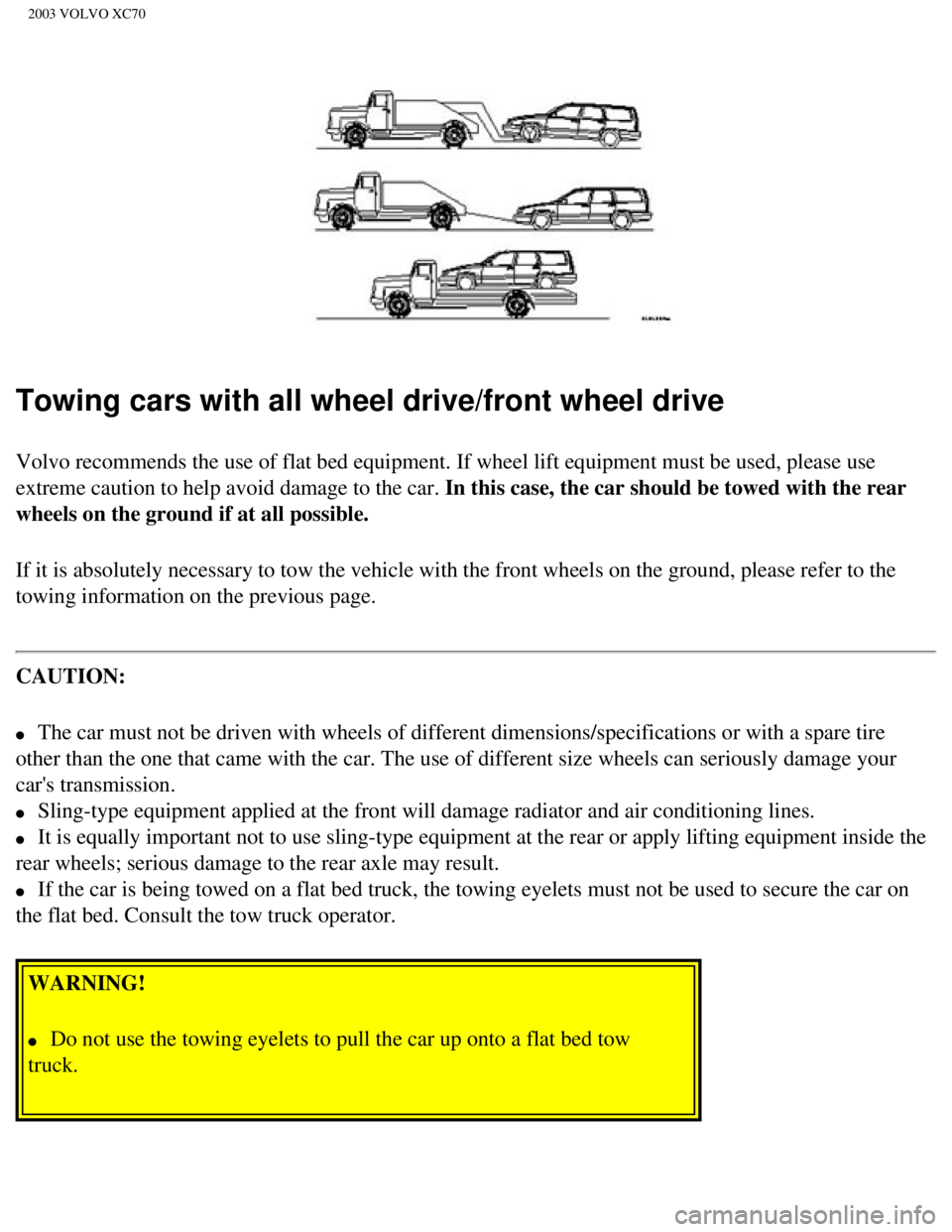
2003 VOLVO XC70
Towing cars with all wheel drive/front wheel drive
Volvo recommends the use of flat bed equipment. If wheel lift equipment \
must be used, please use
extreme caution to help avoid damage to the car. In this case, the car should be towed with the rear
wheels on the ground if at all possible.
If it is absolutely necessary to tow the vehicle with the front wheels o\
n the ground, please refer to the
towing information on the previous page.
CAUTION:
l The car must not be driven with wheels of different dimensions/specifica\
tions or with a spare tire
other than the one that came with the car. The use of different size whe\
els can seriously damage your
car's transmission.
l Sling-type equipment applied at the front will damage radiator and air c\
onditioning lines.
l It is equally important not to use sling-type equipment at the rear or a\
pply lifting equipment inside the
rear wheels; serious damage to the rear axle may result.
l If the car is being towed on a flat bed truck, the towing eyelets must n\
ot be used to secure the car on
the flat bed. Consult the tow truck operator.
WARNING!
l Do not use the towing eyelets to pull the car up onto a flat bed tow
truck.
file:///K|/ownersdocs/2003/2003_XC70/03xc70_06b.htm (3 of 10)12/30/200\
6 4:18:00 PM
Page 149 of 257

2003 VOLVO XC70
pg. 101 Towing a trailer
When preparing for trailer towing, observe the following:
Volvo recommends the use of Volvo trailer hitches which are specially de\
signed for the car.
l Maximum trailer weight recommended by Volvo is:
Trailers without brakes: 1100 lbs (500 kg)
Trailers with brakes: 3300 lbs* (1,500 kg),
Observe the legal requirements of the state/province in which the vehicl\
es are registered.
l All Volvo models are equipped with energy-absorbing shock-mounted bumper\
s. Trailer hitch
installation should not interfere with the proper operation of this bump\
er system.
Trailer towing does not normally present any particular problems, but ta\
ke into consideration:
l Increase tire pressure to recommended full. See section "Wheels and tire\
s".
l When your car is new, avoid towing heavy trailers during the first 620 m\
iles (1000 km).
l Recommended hitch tongue load is:
Trailer weights below 2,650 lbs (1,200 kg) - 110 lbs (50 kg)
Trailer weights above 2,650 lbs (1,200 kg) - 165 lbs (75 kg)
l Maximum speed when towing a trailer: 50 mph (80 km/h).
l Engine and transmission are subject to increased loads. Therefore, engin\
e coolant temperature should
be closely watched when driving in hot climates or hilly terrain. Use a \
lower gear and turn off the air
conditioner if the temperature gauge needle enters the red range.
l If the automatic transmission begins to overheat, a message will be disp\
layed in the text window.
l Avoid overload and other abusive operation.
l Hauling a trailer affects handling, durability, and economy.
l It is necessary to balance trailer brakes with the towing vehicle brakes\
to provide a safe stop (check
and observe state/local regulations).
l Do not connect the trailer's brake system directly to the vehicle's brak\
e system.
l More frequent vehicle maintenance is required.
l Remove the ball and drawbar assembly when the hitch is not being used.
l Volvo recommends the use of synthetic engine oil when towing a trailer o\
ver long distances or in
mountainous areas.
file:///K|/ownersdocs/2003/2003_XC70/03xc70_06b.htm (4 of 10)12/30/200\
6 4:18:00 PM